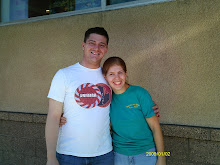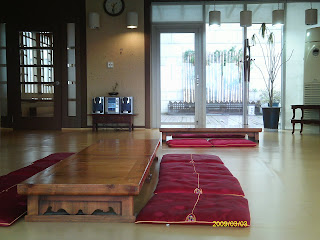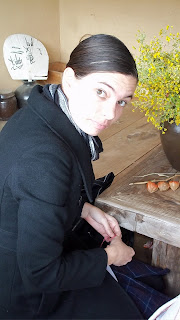Sunday, November 21, 2010
Hero
Thursday, November 18, 2010
Sah Kyehjole: Winter
As a consequence of Texas' unpredictable climate, I was non too prepared for the bare temperatures I felt as I huddled near the warmish space heater in our closet-like office last year. This, I was to learn, was my first real taste of winter's icy fist, which for the next five months locked the peninsula in what Andy liked to call a "frozen tundra." The first snowfall of the season fell in the middle of the night around November 5, uncharacteristically too soon according to many Koreans, with the last falling sometime mid-April. I returned to Korea from my visit to Texas near the beginning of May to find temperatures had only warmed up to a barely-tolerable, layer-peircing five degrees Celcius (40 degrees F). To my dismay, I still needed a long thick sweater on the first of June.
Being that our hagwon was without consistent heating, equipped with the smallest of space heaters that did little to melt the ice-condensation on the floor or erase the visible puffs of breath from our mouths, I was loathe to move from my chair to the classroom for most of 2009's winter season. Each day as I prepared to leave my apartment, its thermostat always set to 30 degrees Celcius (85 F), I layered stockings over stockings and turtlenecks over longsleeve tees to combat the conditions I knew I would find at school. I was never without one of two knit sweaters and always wore a thin jacket underneath my mother's bulky winter coat whenever I stepped out of doors.
Yet for all my layers, my preparations still seemed inadequate to ward off the grip of Korea's icy winter chill. As a way for me to cope mentally with the incessant cold, the running joke in the office with Andy and Brandon was that they should wake me up in three months. My blunders, however, were never far from scrutiny--and this was apparently no exception. Brandon commented one day upon reflection, "You know, you keep saying March. But what if it's still cold [then]?"
But it just had to warm up by March, I was sure--so sure that as I packed my bags the last weekend of February in preparation for my move to Suwon, I stuffed my mom's big blue ski jacket inside a small box and left it at Andy's house, to be picked up at my earliest convenience. Confessing what was inside the box to Andy while en route to my new home, he offered, "Well you know that was a stupid idea." He proved himself right when temperature dipped low again for one "last cold snap" that week, while I huddled without a proper jacket to wait for the bus.
It was a long, bitter winter for the inhabitants (and transient residents) of Korea's pennisula for 2009-2010, with record-deep snowfall at the beginning of January in Seoul and as far south as Chungju. Yet for all its harsh reality, the season still proved itself to be filled with surprises and adventure. My dad once told me that "there's nothing for you in this season." When I offered that to my friend Anna, she observed that perhaps that means I should just look more closely for ways to enjoy it. Though I think Dad is still right on some level, I'm beginning to appreciate the changes, rhythms, and seasons of the life that the LORD brings. Even bitter ones turn beautiful if you let them.
This is the traditional house I stayed in during my visit to Jeonju. The place was cozy and the staff was hospitable, with tea brought to my door and traditional breakfast served hot and fresh in the morning.
During my stay in Jeonju, I visited their cathedral and had a chance to sip a cup of fresh dechu tea with a wonderfully sweet woman from their cultural museum. She sat by me, chatting with me and teaching me snippits of Korean as I savored her sweet creation. Among the many Korean teas availible, dechu remains my favorite.
The day I got Frankie, Dal Cheon took their youth on an outing to go sledding--and took me with them. As I had yet to experience the joy of tumbling down a frozen slope in style, I gave it a try and had a BLAST!
The boys surprised me with a Paris Baugette chocolate cake in the form of a miniature, edible piano for my birthday. There was so much of it left that I divvied it up into cups and passed its pieces out to all my classes throughout the day. I laughed at having to use chopsticks to eat my treat--until I later realized that it's just the norm in Korea to eat cake without a fork.
Lauren, one of the sweetest office staff members there is to work with in South Korea.
Coming on the 24th of February and just after San Antonio's only real cold snap, my birthday always marks the end of winter for me; this year it marked the end of more than just that. Less than a week later, I said goodbye to Chungju and packed my bags to head north for the coming spring and yet a new life season. But not before being serenaded by the musical talents of Mr. Andy Afternoon Levin: My birthday treat was an evening of tasty shabu-shabu followed up with mouth-watering solos, duets, and a group debut of "Happy Birthday" at the local nuraebang.
Boys and Girls of the Ju, here's to you!
Saturday, November 13, 2010
Traditional Concert
The day after my hike in Chungju with Krista, we met up with more of my friends from the Ju for a relaxing drive into the countryside, freshly-made Indian food from Seoul, and a quiet concert in the foothills surrounding the sprawling city. The concert was put on by a friend of Matt's who operates a school out of a traditional house and hosts the event every year to raise money for his students. He also sells homemade preserves, sauces, and gently used items as part of the event to supplement the income from the concert.
To my surprise, dozens of people were present that day to sample the musical and culinary cuisine, including foreigners I didn't recognize. I tried pointing them out to Krista, but ended up with egg on my face.
"Hey look," I nodded to a couple with lighter hair and skin than the surrounding Koreans, not four feet from where they sat. "Here are some waegukins we don't know." It was an assumption dangerous to make in such a tight-knit community like Chungju.
"I know those waegukins," Krista commented with conviction.
I gulped self-consciously as, at that moment, the couple nodded their greeting to my friend. "Hey Krista," they waved.
"Hey," she called back and volleyed conversation back and forth for a few moments.
Oops.
As the crowd waited for the food to be ready, different stations throughout the compound were set up for amusement. In one booth, girls were making beaded cell phone charms and in another, traditional Nepalese games were being played. Krista and I tried our hands at playing one of the games with Moon Hae, my Canadian friend Jason's wife, and a group of her friends. The object of our chosen game was to get all three of your team's coins from one end of a string of shells to the other. I could see this as being a successful pastime for hotter, dryer climates like those in the Middle East: It looked like something nomadic tribesmen might enjoy, portable as it was without needing the use of a gameboard.
The game was played by first rolling dice in a small wooden cup, and the outcome of the roll told you how many shells to move. You then grabbed your alloted handful, scooted them over, and nestled your coin safely amid the other shells, to repeat your success the next round. It was none too easy, however, because your oponents could, in persuit of the same goal, usurp your coin and place it back at the start of the shells. Competition was so intense that when Jason came to tell us lunch had been served, we couldn't leave until the game was finished and the winning team declared.
After a meal of fresh nan and spicy Indian curry, we sat down in the courtyard of one of the traditional houses on the compound to enjoy the musical delights of my friend Anna and another talented instrumentalist. Anna first played soothing Hindi music for us on her sarangi, a classical stringed instrument from India that sits on your lap and is played much like a dulcimer. She then taught us to sing a song in Hindi using cards in English and Korean displaying each vocal note. The final performer for the night was a multi-talented, multi-intrumental musician who wooed the gathered crowd with exotic notes sounds from far away places, whiskingus away to Africa on the notes of his whimsical song.
All in all, it was a fun time with my friends from Chungju whom I rarely get to see these days. The cuisine was spicy yet satisfying, the music entertaining, and the company enjoyable--a truly beautiful afternoon.
My friend Krista beading a cell phone charm: Since my phone has no hook on which to hang such beauty, the one I made has become a camera charm instead.

Here, ladies wash the dinner dishes Korean-style, squatting outside near a spigot and a large vat of dirty plates and cups.
This is my beautiful friend Anna and her Korean beau. She showcased her musical talents on a sarangi at the concert later that day.
This was the final act of the afternoon, a rather gregarious Korean who entertained us with his many strange instruments.
































































